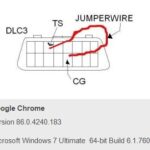Experiencing a no-start condition in your 2011 Nissan Maxima can be incredibly frustrating. One owner recently shared their puzzling experience, which might shed light on potential issues and how they could relate to your vehicle’s OBD2 system. This situation highlights the complexities of modern vehicle electronics and the diagnostic paths we sometimes need to explore.
The owner’s 2011 Nissan Maxima suddenly refused to start. The symptoms were concerning: a completely dead dashboard, a locked steering wheel, and a stiff brake pedal. Initial troubleshooting steps, such as disconnecting and reconnecting the battery for short periods, yielded no results. This pointed to a potentially deeper electrical or system-wide problem, possibly beyond a simple battery issue.
Interestingly, leaving the battery disconnected for an extended period – around 24 hours – seemed to resolve the problem. Upon reconnecting the battery after this longer duration, the car started without any apparent issues, as if the problem had vanished. This temporary fix, however, raises more questions than answers and fuels concerns about underlying issues.
The locked steering wheel and brake pedal are classic indicators of an active immobilizer system. The immobilizer is a security feature designed to prevent theft by disabling the engine unless the correct key or key fob is present and recognized by the vehicle’s computer system. While the owner had changed car batteries before without incident, this situation suggests a possible glitch or malfunction in the immobilizer or related systems.
Attempts to manually override potential immobilizer engagement, like applying force to the steering wheel while trying to start, were unsuccessful. Similarly, key fob functions like remote locking/unlocking and the panic button were unresponsive, further suggesting a broader electrical or system control problem. The fact that only physically using the key in the door lock worked points towards a potential issue with the key fob receiver or the system that controls these functions.
The owner’s research into aftermarket security systems, specifically KARR systems, adds another layer to the puzzle. These systems often integrate with the vehicle’s Body Control Module (BCM) and can act as immobilizers. If a KARR system malfunctioned or was inadvertently triggered, it could potentially cut power to essential systems like the BCM and key receiver, leading to the observed symptoms.
While disconnecting the battery for a prolonged period seemingly reset something and allowed the car to start, this is unlikely to be a permanent solution if an underlying fault exists. It’s crucial to understand that simply disconnecting the battery is not an “OBD2 hack” to fix car problems. OBD2 (On-Board Diagnostics II) is a system designed for diagnosing vehicle issues using a scanner to read diagnostic trouble codes (DTCs) from the car’s computer. In this scenario, while an OBD2 scan might not have prevented the no-start initially, it could be invaluable in identifying stored codes that might offer clues about what went wrong.
Taking the 2011 Nissan Maxima to a dealership for a professional diagnosis is a prudent step. Even though the car is currently running, a thorough diagnostic check, including reading any stored OBD2 codes and inspecting the BCM, immobilizer system, and any aftermarket security systems, is essential to pinpoint the root cause. A skilled technician can use diagnostic tools to probe deeper into the car’s electronic systems and potentially uncover intermittent faults that might not be immediately apparent.
In conclusion, while the 24-hour battery disconnect provided temporary relief, the mystery of why this 2011 Nissan Maxima initially wouldn’t start remains. Focusing on the potential role of the immobilizer system, the BCM, and considering aftermarket security systems like KARR is a logical approach. Ultimately, a professional diagnostic scan using OBD2 tools and expert inspection are necessary to ensure the reliability and prevent future no-start scenarios.
